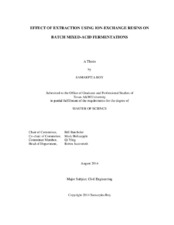| dc.description.abstract | Biofuels are increasingly gaining importance as an energy source. The MixAlco® process is a biomass-to-energy technology that uses mixed cultures of microorganisms to convert biomass to mixed carboxylic acids. Using a buffer, the acids are neutralized to their corresponding salts, which are recovered from the fermentation broth. Finally, the carboxylate salts are chemically converted to mixed-alcohol fuels, hydrocarbon fuels (gasoline, jet fuel, etc.), and industrial chemicals. To be a viable alternative to fossil fuels, biofuels must be economical, provide a net energy gain, and be easily produced in large quantities. Previous studies have shown that as product concentration increases, the fermenting microorganisms are increasingly inhibited, which lowers production rates and yield.
Maintaining low carboxylate salt concentration in fermentors reduces product inhibition and allows microorganisms to function efficiently and increase biomass digestion. In this study, anion-exchange resin (Amberlite IRA-67) was used to extract carboxylate salts from fermentation broth and thereby maintain near-neutral pH. Three different batch fermentations were performed using the following substrates: α-cellulose powder, shredded office paper, and lime-pretreated corn stover. It was observed that periodic extraction of carboxylate salts reduced product inhibition and thereby increased acid production in the fermentors. For all substrates, fermentors that employed an ion-exchange resin column for acid extraction had higher yield than fermentors where magnesium carbonate (MgCO_(3)) was used as a buffer to maintain pH.
The yield expressed as gram total carboxylic acid produced per gram non-acid volatile solids (NAVS) fed were 0.15 (MgCO_(3) control) and 0.35 for α-cellulose substrate, 0.24 (MgCO_(3) control) and 0.37 for paper substrate, and 0.20 (MgCO_(3) control) and 0.35 for lime-pretreated corn stover. Other fermentation parameters such as conversion and selectivity also improved with periodic carboxylic acid extraction. The production of high-molecular-weight acids significantly increased for fermentors with IR extraction. This is important to the MixAlco® process because it generates high-energy products. | en |


